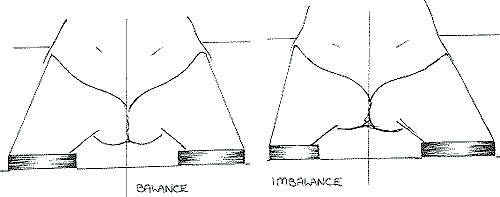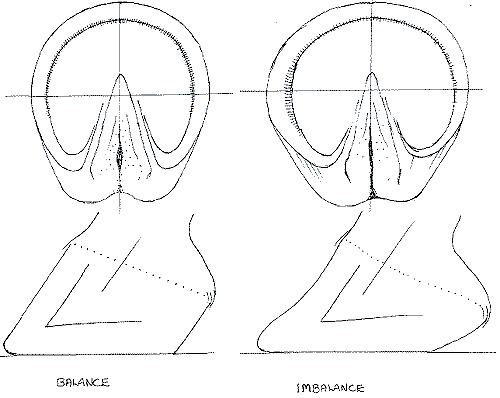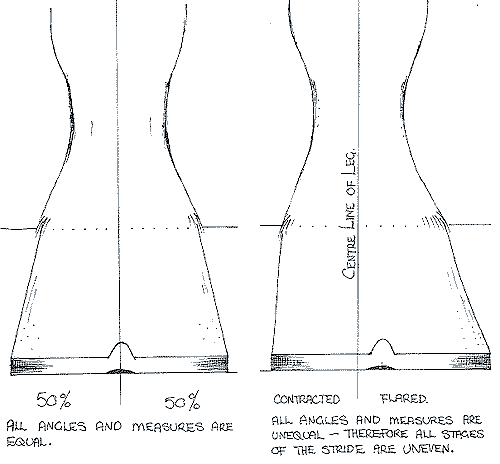

Balance Defined
John Crowley BVSc (Hons.) MRCVS
Illustrations- Copyright J. Mulholland
A balanced horse should perform to his optimal level, have fewer soundness problems, be more comfortable to ride and less likely to slip or fall.
In order to have a balanced horse, his feet must be "balanced".
The feet must be symmetrical, land evenly, breakover centrally, and have an efficient flight path. Additionally the foot must be aligned to the leg when viewed from all aspects.
A perfectly balanced foot can only be achieved if the conformation of the legs is very close to normal. If there is a conformational problem, balancing the foot becomes an art of corrective shoeing and trimming to bring the alignment back towards normal.
Balancing a horse's hoof is more of an art than a science.
There are too many variable factors to be considered in allowing simple measurements to provide an alternative method of assessing balance.
Likewise, balance is difficult to describe in scientific terms and is much easier to comprehend with diagrammatic or artistic methods.

So, let's try to define a "balanced hoof."
I regard a balanced foot as one that either wears naturally, is trimmed, or shod in such a way it allows a horse to move in the most efficient manner that his conformation allows, and to distribute the forces as evenly as possible through the feet and legs. Balance must be considered from all aspects.
Firstly, let's look at Medio-Lateral (ML) Balance.
This is determined by observing closely from the front and rear of the leg, preferably with the horse standing and moving on a hard level surface.

ML Balance
Perfect ML Balance on a perfectly conformed leg has the following features:
ML1) A line drawn down the centre of the leg should bisect the hoof. In other words the hoof should be directly under the centre of the leg. ML2) The walls should be of equal length on the medial and lateral sides of the hoof. ML3) The angle of the wall should be equal on medial and lateral sides. ML4) The foot should have a flat footfall. ML5) The heels should be of equal height. ML6) The distance between the central sulcus and the widest part of the quarter should be the same on the medial and lateral sides.
AP Balance
The Antero-Posterior Balance (AP Balance) is determined best when the horse is observed from the side.
As with ML Balance, there is a variation from "perfect" in most horses, and some breeds, depending on their use, are selected for conformations and other parameters that may differ "significantly" from "perfect".
This is especially true with AP Balance, eg: some Quarter Horses are much more upright in pastern angle than Thoroughbreds, and even sprinting bred Thoroughbreds are usually more upright than staying-bred horses.
The Principles of AP balance are:
AP1) A line drawn down through the centre of the cannon bone should drop to the ground no further back than the tip of the heel or shoe. AP2) The angle of the shoulder should be similar to the angle of the pastern, and the angle of the hoof. AP3) The angle of the wall at the heels and the toe should be similar. AP4) The length of toe should not delay the breakover unduly. AP5) The hoof should land flat or slightly heel first, but not toe first, except when going uphill or when accelerating from slow speeds to a gallop.

Deviation & rotation
Deviation and Rotation are separate but commonly-associated conformational problems.
Rotation is another form of imbalance and commonly occurs because one side of the foot lands before the other side, causing the landing side to break. The other side continues with the movement of the leg.
The foot rotates towards the landing side. This is often called the "cranking" effect.
If the foot lands on the outside, it is usually "cranked out." If it lands on the inside it usually "cranks in".
Rotation has a severe effect on soundness and performance. Correction is based on reversing the cause, usually trimming and shoeing to land flat.

|